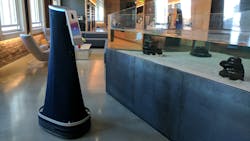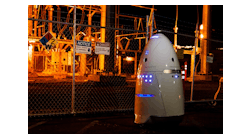Several years ago when the concept of using robotics for security applications was first introduced, the technology was met with a certain degree of optimism as well as skepticism from the industry.
Like any new solution, robotics – be it unmanned ground vehicles (UGVs) or unmanned aerial vehicles (UAVs), commonly referred to as drones, – presented a number of potential advantages to end-users, such as being able to be remotely deployed around-the-clock in a wide variety of environments. Conversely, there were also concerns about the costs of deploying robots, not only with regards to how much would have to be spent to purchase or lease them but also costs associated with their ongoing maintenance.
Following several initial deployments, many privacy advocates also voiced concerns over how much personal data was being collected and stored by security robots and some even saw their arrival as the end of the manned guarding industry. The fact is the use of robotics for security applications is still in its early days and that many of the technology’s providers continue to fine tune their offerings to meet the needs of the marketplace.
SecurityInfoWatch.com (SIW) recently reached out to senior leaders at three security robotics firms, including Dr. Travis Deyle, CEO and Co-Founder of Cobalt Robotics, Stacy Dean Stephens, EVP and Chief Client Officer at Knightscope, and Steve Reinharz, the Founder and CEO of Robotic Assistance Devices (RAD), to get their take on how far robots have come in the industry and the obstacles they must still overcome to gain wider adoption moving forward.
SIW: How would you characterize the industry’s initial reception of robotic technologies and how has that changed over time?
Deyle: Robots have historically had cultural challenges due to previously deployed systems that did not perform as promised. They are elaborate pieces of equipment with hardware, machine learning, artificial intelligence, and web components, so there are technological, cultural, and use-case challenges that need to be addressed.
When looking at the short-term evolution of robotics, the focus should be on nailing the customer's immediate needs. We have incredibly capable hardware that can compute and sense. We can also remotely enable new capabilities via software updates without ever needing to take a robot offline. This evolution is already happening. You can easily add value with these machines, such as using RFID to track assets throughout their life cycles. With asset tracking, for example, the robot can complete an inventory analysis and pinpoint the location for every high-value asset in 15 minutes.
Stephens: The industry’s initial reception was definitely encouraging – initial skepticism fell aside as security professionals saw the potential that robots presented. Over time, robots have proven their value and the wide array of robots now in use suggest public opinion is indeed positive. Knightscope itself now has security robots deployed in 16 states across four times zones and operating 24/7.
Reinharz: Initial reception was a mix of curiosity and skepticism. I think we remain in that state despite the fact it’s been a couple years since the first movers began promoting and demonstrating their solutions. Some of this is due to the requisite paradigm shift in thinking on behalf of security practitioners, first movers figuring out how to maximize value and the challenges of early adoption. That said, I see tacit acceptance that the industry is on the verge of a significant paradigm change involving the use of robotics, AI and human assets to improve overall security while reducing cost. For the next few years, adoption will come from advanced adopters investing, understanding and reaping the benefits as opposed to an entire industry shift.
SIW: Where do you see the sweet spot in terms of applications for robots in security these days? Is it still primarily in those “dirty, dull and dangerous” roles or are their roles expanding?
Deyle: Marrying the benefits of robotics with the unique capabilities of humans means creating something that is greater than the sum of its parts. The reliability of robots for tasks that require unwavering attention or precise repetition is unmatched. When you expand the capabilities of a robot by integrating its work with that of a human for flexible decision-making, you're enabling a greater level of effectiveness for roles that are more than just the dirty, dull, or dangerous. In this sense, the sweet spot for robotic application is greatly expanded. A robot can detect leaks and spills in a building before a human, and working with a human to address the leak or spill can correct the anomaly. This is not a dirty, dull or dangerous role, but it is one with the potential to greatly impact business operations.
Stephens: Roles for security robots are rapidly expanding. Much like parking a police car outside a business or home, the physical presence of a security robot on a property can serve as a deterrent to a potential crime. Additionally, the constant technological innovation taking place has resulted in cases where data provided by robots has become the primary evidence in prosecution. It’s unfortunate, but a large-scale crime can happen anytime, anywhere. People want to feel safe. Robots can help fulfill that need serving as the first line of defense.
Reinharz: Certainly at the moment their role is primarily dirty, dull and dangerous. However, I see emerging technologies for advanced detection analytics such as leak detection, missing object, open door, and so on, driven by advanced video analytics. There remain fantastic capabilities that are being in worked on in lab environments. In the near future, I see these as being commercialized and further expanding the gap between legacy security solutions and modern security solutions.
SIW: How has robotic technology itself changed within the security industry? Is it still essentially the same or have you and your contemporaries in the field had to go back to the drawing board to meet the unique security demands of various customers?
Deyle: Security robots are an old idea, dating back at least to the mid-1960s with the development of some of the first mobile robots, such as Shakey from SRI's Artificial Intelligence Center. If we look back just 10 years, we had phenomenally capable robots. I earned my Ph.D. building healthcare robots—robots with arms, operating in homes, and working closely with people (e.g. older adults for aging in place). These robots were phenomenally capable, but incredibly expensive. The big change in recent years is the economic viability of robot solutions: better hardware, better communications, and better computer algorithms. The biggest challenge faced by the industry remains the same: being intellectually honest and realistic—identifying clear use-cases, demonstrating clear ROI, operating in an inherently safe and secure manner (both physical and cyber context), and creating future roadmaps.
Stephens: I think it’s less about change and more about evolving robotic technology. New innovations and opportunities are constantly presenting themselves. Over the past five years, we’ve continued to evolve the robot’s design and capabilities to meet not just the needs of our customers, but to keep pace and even stay one step ahead of evolving criminal activity.
Reinharz: We have gone back to the drawing board for our forthcoming rolling robot. There are recently launched technical elements that we are applying that we did not have access to in our generation 1 rolling robot. There is no question that application of these new technologies will result in improved functionality and reliability.
SIW: What would you say are some of the biggest obstacles that robotics must still overcome in security?
Deyle: The cultural acceptance of robots in the workplace will be a challenge for as long as it takes to help people understand the reason for its use. In security, people may look at any type of technology as a mechanism to report bad behavior. When you use robotics in security, there is more mobility in the technology than there is in a camera or access control system, and this can create a greater sense of apprehension among people in the workplace. Training and educating people on the benefits of and reasons why behind robotics through clearly identified use-cases, and an honesty in the marketing of what robots can do today and what they can do tomorrow, can bridge that obstacle.
Stephens: Some of the biggest obstacles include the stigma of robots and the fear of the unknown. Some people hear “security robot” and think some “Robocop” is going to go rogue or get hacked and endanger lives. People also believe that security robots will take jobs from people. This could not be further from the truth. Security robots are there to be eyes and ears for trained security professionals and transmit relevant and real-time information so that potential crime events can be immediately addressed.
Reinharz: There must be greater functionality and use-cases that offer high value and high return on investment. To work through this obstacle, more advanced visual technologies for identifying and processing anomalies must be brought to market. I see tremendous value in this area because this allows us to outperform legacy solutions and deliver tremendous ROI. Technical advances in robotics technology over the last two years have allowed tremendously improved functionality and reliability so I see most obstacles coming from the challenges of communicating high value applications.
SIW: What trend do you believe is going to have the biggest impact on demand for robots within the security industry moving forward?
Deyle: Artificial intelligence and machine learning allow the capabilities of robots to grow with their environments. In security, this is essential for greater situational awareness and understanding of the nuances of a workplace. The demand for security robots will grow as companies look towards technology to solve staffing shortages and amplify security manpower as more businesses place increasing demands on employees. Robots will be essential force multipliers as companies evolve with their workforce, managing and maintaining security, while also integrating with broader facilities operations.
Stephens: In a word: results. Seeing is believing and as security robots continue to make an impact on crime, demand will increase. These kinds of results have resonated with potential customers as they see the benefits that robots offer not just in terms of ROI, but because crime continues to unfortunately be a huge problem in our country and as a result, safety has become a top priority for businesses of all types.
Reinharz: The eventual expected trend of proliferation of security robots will be driven by ROI and that means that our robots need to perform their tasks exceptionally well - simple as that. Practitioners are driven to perform their jobs to the highest degree possible and, if robots can help them achieve performance and pricing advantages, they’ll drive adoption. 2019 will be a big year in terms of arrival of high value solutions that will begin to drive this trend. Even now, stationary and mobile robots have built an impressive list of use-cases. I expect these to exponentially multiply in 2019 as functionality continues to improve and then we’ll all take part as this trend becomes the norm.
About the Author:
Joel Griffin is the Editor-in-Chief of SecurityInfoWatch.com and a veteran security journalist. You can reach him at [email protected].




